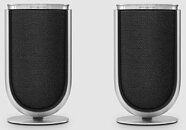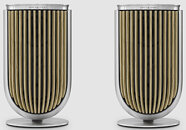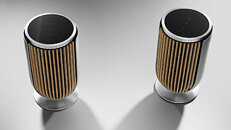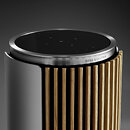TheLostSwede
News Editor
- Joined
- Nov 11, 2004
- Messages
- 18,472 (2.47/day)
- Location
- Sweden
| System Name | Overlord Mk MLI |
|---|---|
| Processor | AMD Ryzen 7 7800X3D |
| Motherboard | Gigabyte X670E Aorus Master |
| Cooling | Noctua NH-D15 SE with offsets |
| Memory | 32GB Team T-Create Expert DDR5 6000 MHz @ CL30-34-34-68 |
| Video Card(s) | Gainward GeForce RTX 4080 Phantom GS |
| Storage | 1TB Solidigm P44 Pro, 2 TB Corsair MP600 Pro, 2TB Kingston KC3000 |
| Display(s) | Acer XV272K LVbmiipruzx 4K@160Hz |
| Case | Fractal Design Torrent Compact |
| Audio Device(s) | Corsair Virtuoso SE |
| Power Supply | be quiet! Pure Power 12 M 850 W |
| Mouse | Logitech G502 Lightspeed |
| Keyboard | Corsair K70 Max |
| Software | Windows 10 Pro |
| Benchmark Scores | https://valid.x86.fr/yfsd9w |
Whether it's the ultimate sound system in the home or a single point of sound, Beolab 8 can be used as a system speaker to create an immersive home cinema setup using the latest high-end Bang & Olufsen speakers or even heritage speakers dating back to 1984. Stereo pair two Beolab 8 speakers to create powerful and precise stereo sound for a high-fidelity music experience. Beolab 8 is also a stand-alone speaker delivering depth with an intense bass for its size.
"Our goal is to create powerful and immersive listening experiences for our customers. Beolab 8 provides exactly this. It is a scalable speaker that is all about flexibility, performance, and innovation", says Michael Henriksson, Vice President of Product Marketing at Bang & Olufsen and continues: "Drawing inspiration from the high-end Beolab range, our aim for Beolab 8 was to distil the acoustic essence of these impressive speakers into a compact offering that maintains the directivity and sound beam control for optimal sound reproduction in any environment. Bringing immersive experiences for every moment".




Excellence in craftsmanship
Beolab 8 is designed to look beautiful from every angle, no matter where and how the speaker is placed. The one-piece aluminium body is a fusion of a sphere and cylinder merged into a solid shape, showcasing excellence in craftsmanship from Bang & Olufsen's renowned Factory 5. Designed with either Danish manufactured wooden lamellas or a fabric front, Beolab 8 follows the same characteristic design of Bang & Olufsen's Beolab and Beosound products including Beosound Theatre, Beolab 28 and Beolab 50.
In between the outer aluminium shell and the inner core of the speaker, the interplay of light and shadow create a visually lightweight appearance. In keeping with Scandinavian design principles, where form follows function, the shape of the speaker dually creates an aesthetic object and enhances the acoustics of the speaker. The glass interface on top of the speaker creates a perfect curve that guides the user's finger along the surface effortlessly.
Each of the four stand options are slender and sculptural, utilising Bang & Olufsen's expertise in aluminium manufacturing. While the table stand is designed to create a floating illusion, the discreet ceiling bracket and floor stand are polished to perfection.
Powerful, immersive sound
Tuned by Bang & Olufsen tonmeisters, listeners can enjoy the sound quality of a Beolab speaker thanks to its three-driver setup consisting of a 16 mm tweeter, 3" midrange and a 5.25" woofer. Building on the heritage of the iconic Beolab 17 speaker, Bang & Olufsen tonmeisters carefully selected drivers that maintained the same performance and sound quality of these speakers.
However, the performance in Beolab 8 is significantly improved thanks to the incorporation of beam width control, room compensation, adaptive tuning as well as ultra-wideband technology.
Design that stands the test of time
Beolab 8 is designed to stand the test of time: using quality materials that age gracefully, continuous customisation options and easy upgradability over time, long term serviceability as well as the replaceable streaming module to ensure that Beolab 8 can adapt to the latest technology standards. The speaker is designed using Cradle-to-Cradle principles - a design philosophy which allows products to be proactively designed for a circular future. Beolab 8 is pending to complete Cradle-to-Cradle Certified.
Pricing and Availability
Beolab 8 is available in an array of customisable colourways.
Choose from: Silver / Natural Aluminium, Gold Tone or Black Anthracite, and combine with speaker covers in oak, light oak, dark oak, or fabric.
Prices start from: 18,490 DKK / 2499 EUR / 2199 GBP / 2749 USD
View at TechPowerUp Main Site | Source
"Our goal is to create powerful and immersive listening experiences for our customers. Beolab 8 provides exactly this. It is a scalable speaker that is all about flexibility, performance, and innovation", says Michael Henriksson, Vice President of Product Marketing at Bang & Olufsen and continues: "Drawing inspiration from the high-end Beolab range, our aim for Beolab 8 was to distil the acoustic essence of these impressive speakers into a compact offering that maintains the directivity and sound beam control for optimal sound reproduction in any environment. Bringing immersive experiences for every moment".




Excellence in craftsmanship
Beolab 8 is designed to look beautiful from every angle, no matter where and how the speaker is placed. The one-piece aluminium body is a fusion of a sphere and cylinder merged into a solid shape, showcasing excellence in craftsmanship from Bang & Olufsen's renowned Factory 5. Designed with either Danish manufactured wooden lamellas or a fabric front, Beolab 8 follows the same characteristic design of Bang & Olufsen's Beolab and Beosound products including Beosound Theatre, Beolab 28 and Beolab 50.
In between the outer aluminium shell and the inner core of the speaker, the interplay of light and shadow create a visually lightweight appearance. In keeping with Scandinavian design principles, where form follows function, the shape of the speaker dually creates an aesthetic object and enhances the acoustics of the speaker. The glass interface on top of the speaker creates a perfect curve that guides the user's finger along the surface effortlessly.
Each of the four stand options are slender and sculptural, utilising Bang & Olufsen's expertise in aluminium manufacturing. While the table stand is designed to create a floating illusion, the discreet ceiling bracket and floor stand are polished to perfection.
Powerful, immersive sound
Tuned by Bang & Olufsen tonmeisters, listeners can enjoy the sound quality of a Beolab speaker thanks to its three-driver setup consisting of a 16 mm tweeter, 3" midrange and a 5.25" woofer. Building on the heritage of the iconic Beolab 17 speaker, Bang & Olufsen tonmeisters carefully selected drivers that maintained the same performance and sound quality of these speakers.
However, the performance in Beolab 8 is significantly improved thanks to the incorporation of beam width control, room compensation, adaptive tuning as well as ultra-wideband technology.
- The speaker's beam width control allows users to seamlessly switch between two listening experiences. Beolab 8 offers the ability to narrow down with precision audio to optimize the sweet spot for the listener. Alternatively, users can choose to go wide and diffuse sound throughout the room whilst the front LED's on the speaker display which sound mode status the speaker is in.
- Beolab 8's Room Compensation feature provides an optimised soundscape based on a room's unique acoustics. The speaker carefully maps its environment to deliver crystal clear quality no matter the size or space of the room. A neodymium motor allows listeners to enjoy a soundscape adapted to their surroundings for full music immersion.
- With adaptive sound tuning, Beolab 8 adapts to its own configuration by using sensors to detect the front cover and fine-tune the sound for optimal performance. This is made possible through small sensors in the speaker and magnets within the cover which allows Beolab 8 to detect the type of cover and automatically apply the appropriate tuning.
- Utilising ultra-wide band technology, Beolab 8 does more than just adapt to the room it is placed in. It can also direct the acoustic sweet spot based on a user's phone location via the Bang & Olufsen app, ensuring immersive sound for a dynamic sweet spot experience.
- With Bang & Olufsen's Mozart platform at the heart of the product, Beolab 8 as a stand-alone product can connect easily through WiFi 6 and Bluetooth 5.3. And with Powerlink, both wireless and wired built into the speaker, Beolab 8 is a true system speaker, providing a connection to Bang & Olufsen TVs and sound systems dating back more than 30 years.
Design that stands the test of time
Beolab 8 is designed to stand the test of time: using quality materials that age gracefully, continuous customisation options and easy upgradability over time, long term serviceability as well as the replaceable streaming module to ensure that Beolab 8 can adapt to the latest technology standards. The speaker is designed using Cradle-to-Cradle principles - a design philosophy which allows products to be proactively designed for a circular future. Beolab 8 is pending to complete Cradle-to-Cradle Certified.
Pricing and Availability
Beolab 8 is available in an array of customisable colourways.
Choose from: Silver / Natural Aluminium, Gold Tone or Black Anthracite, and combine with speaker covers in oak, light oak, dark oak, or fabric.
Prices start from: 18,490 DKK / 2499 EUR / 2199 GBP / 2749 USD
View at TechPowerUp Main Site | Source



 .
. 